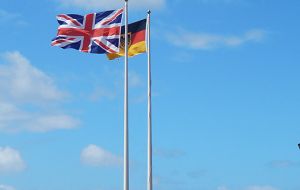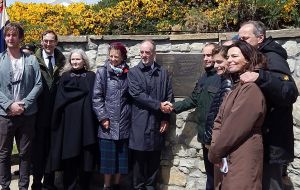MercoPress. South Atlantic News Agency
Reconciliation and commemoration: 100 years after the Battle of the Falklands German flags fly over Stanley
 British and German flags on Victory Green
British and German flags on Victory Green  Descendents of Admirals Sturdee and Cradock (L) shake hands with decendents of Admiral Graf von Spee
Descendents of Admirals Sturdee and Cradock (L) shake hands with decendents of Admiral Graf von Spee “With substantial losses at both the Battle of Coronel and the Battle of the Falklands, the annual remembrance events are an opportunity to reflect on the lives lost from both the British and German navies. It was decided early on that this commemorative approach, highlighting the tragic loss of life during both battles, should be echoed throughout events on this Centenary year”
The above quotation from a Member of the Falkland Islands Legislative Assembly, Phyl Rendell MBE, sums up the tone of a week in the Islands when the emphasis has been on the commemoration rather than celebration of two early and decisive naval battles of the First World War.
Perhaps understandably, the view of both battles was somewhat different in the Falkland Islands one hundred years ago. Some weeks earlier, the people of Stanley had said goodbye to the sailors of HMS Good Hope and HMS Monmouth, who had been tasked to find the German Asiatic Squadron commanded by Vice-Admiral Maximilian Graf von Spee. On November 1st, both these warships were sunk and 1,600 men, including their commander, Rear Admiral Sir Christopher Cradock, died off the coast of Chile at the Battle of Coronel. After Coronel, the same German naval squadron turned its attention to the Royal Navy’s coaling depot and the wireless station in Stanley harbour and it seemed to the inhabitants that invasion was likely. Some five hundred people, mainly women, children and the elderly were evacuated to outlying farm settlements.
According to contemporary reports, on the morning of December 8th 1914 “everyone who could walk” of those remaining in Stanley, or not called out for duty with the Falkland Islands Volunteer Force, climbed the hills behind the town to watch as a newly arrived Royal Navy squadron, under the command of Rear Admiral Sir Doveton Sturdee, made haste to put to sea in pursuit of the surprised enemy. By the end of the day, with the majority of the German squadron sunk, 2000 German lives had been lost, including those of Graf von Spee and his sons. With the exception of some who were aware of the tragic consequences of the event, it seems the general mood among the spectators on the high ground around Stanley was largely exultant and despite the fact that the naval gun fire caused the ground to shake at times, most people remained throughout the day, supplied with fizzy drinks, buns and sausage rolls by entreprising local businesses. Until 3pm, when, we are told, it began to rain, the day was sunny and calm.
Since 1914, December 8th has become a national holiday in the Falklands, marked in Stanley, each year by a service in the Cathedral, a military parade and a further act of remembrance at the Battle of the Falklands Monument to the West of Government House. During this act wreaths are laid on behalf of the Governor, the Falkland Islands Government, the British military, ex-servicemens’ associations and others.
This year, despite a cold and gusty wind which made walking difficult, almost certainly more people turned out to attend than gathered to watch the battle in 1914, and the mood was different. Included in the participants and wreath layers this year were descendents of the admirals from both sides of both battles, as well as other distinguished guests, including the Mayor of Coronel, Sr Leonidas Romero Saez. Among the wreath layers was Commander Jan Hackstein, Naval Attaché for the German Embassy in London and prayers were said for the dead on both sides.
The mood of commemoration and reconcilitation was continued at a further ceremony at the specially constructed memorial wall commemorating the battles of Coronel and the Falklands, a little to the East of the Falklands Battle Memorial. Here, three brass plaques bearing the images from the battles and the portraits of Admirals Von Spee, Sturdee and Cradock were unveiled, having been at first covered by the ensigns of the Royal Navy, the German Navy and the Falkland Islands.
Elsewhere in Stanley, on Victory Green, the German flag now flies for this week along side the British flag as a symbol of what was referred to during the ceremony as a “new relationship” between Germany and the Falkland Islands. Outside the Upland Goose Hotel also, the German naval ensign flies alongside that of the Royal Navy and the flag of the Falkland Islands.
At the end of the unveiling, the descendants of all three admirals posed for a group photograph and shook hands as a sign of friendship.
By John Fowler - Stanley




Top Comments
Disclaimer & comment rules-

-

-

Read all commentsTWIMC
Dec 09th, 2014 - 12:35 am 0Article says...:
“the emphasis has been on the commemoration rather than celebration of two early and decisive naval battles of the First World War”
I say...:
That's why the former enemy flags were flown along side on “Victory Green”...
Ain't “Victory Green” the one besides “Gotcha Avenue”?
Anyhow.... Is it me... or isn't that Engrish flag flying a tad higher than the Schwartz-Rot-Gelb?
It's you.
Dec 09th, 2014 - 01:51 am 0When you speak, it's always about you.
You are imagining things, again.
By contrast, in actuality, it was a day of noble sentiments, honouring all of the fallen.
In the meanwhile.......in Argentina the repatriation of Kenneth Charney better known as the “Black Knight of Malta” (The Black Knight of the Malta) is being launched.
Dec 09th, 2014 - 03:42 am 0As an Argentine-born volunteer in the RAF with 6 confirmed victories, 4 probable and 7 damaged. He was head of Pierre Clostermann, his companion and his comrade when he directed the RAF 602 squadron composed of volunteers from around the world. Charney began his outstanding career as a pilot in the squadron 185 Spitfires being one of the key drivers for the defense of Malta, was there where he got his first 4 wins. A long list of victories. Ken was commander of the squadron of Spitfires XVI 132 “City of Hong Kong”. It was the pilot who discovered the German forces initiated its withdrawal from Normandy through Falaise and detection allowed the 2 Tactical Air Force significantly reduce the firepower of the Germans in that sector. He was awarded twice with DFC or Distinguished Flying Cross for his actions.
Retired from the race and, after having suffered the loss of many comrades, he lived in the beautiful valleys of Andorra and it was there where he began his ascent in search of their comrades in June 1982.
It was his desire to return to Argentina and that's what it starts in a few weeks
Accompanied by argentine pilots (some veterans of Malvinas War) who will welcome him and, finally, his remains will be buried in a public ceremony so all those who want would be able to attend it.
Commenting for this story is now closed.
If you have a Facebook account, become a fan and comment on our Facebook Page!